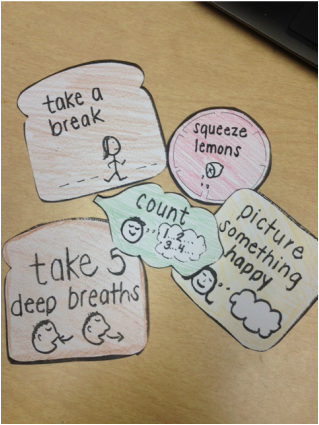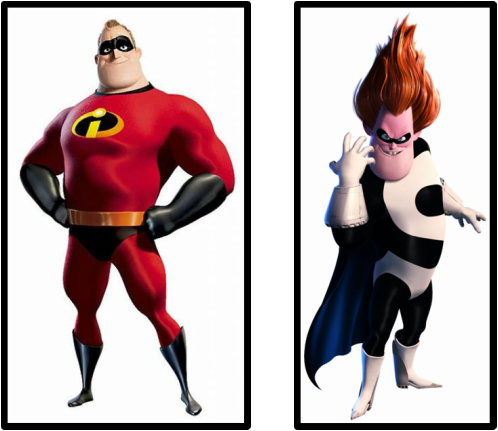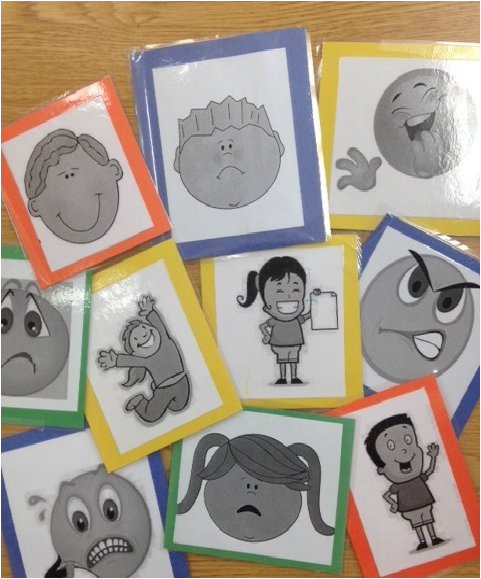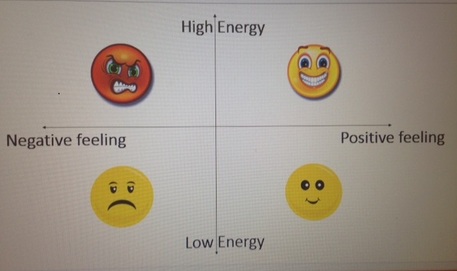Wishing you and your families a wonderful holiday break! I hope this time is filled with family, friends, and relaxation for all. See you in 2016!
|
To help our second graders learn to grow their brains the most they can every day, we talked about how positive thinking affects our choices and feelings. Students listened to a variety of negative "red" thoughts, followed by a group of positive "green" thoughts. We discussed the difference, predicted what people who thought each way might do, and empathized with how each of those students might feel.
Students then worked in partners to sort and connect positive and negative thoughts, actions and feelings. I hope to hear students using growth mindset language in their classrooms to help promote positive learning choices and encourage our students to feel great about tackling challenges! Fourth grade students are continuing to develop their problem solving skills by examining different points of view to a conflict situation. Students listened to the "Weird!" series of books by Erin Frankel, and talked about how three points of view -
Students did a great job building connections between the three points of view, and empathizing with each character. We wrapped up our until by talking about the importance of the bystander, who through witnessing a mean behavior has the opportunity to be passive, harmful, or helpful. Our goal is to show our core values through helping either the person being picked on by doing something kind like inviting them to play, or by using our courage to stand up to the person doing mean behaviors. When we stand up as a team, we create a safe and respectful community for our school! I will return to our 4th grade classrooms in the spring to talk more about academic strategies to build independent study skills, and help facilitate the transition into middle school. It will come up faster than we think! Until then, enjoy the holiday season and Happy Thanksgiving! For their fall developmental guidance unit, our 2nd grade students are learning all about growing their brains. The idea that we can grow our brains comes from the concept of growth mindset. This concept, developed by Carol Dweck, PhD., is based on the belief that our qualities (intelligence, traits, talents) can be developed through dedication and effort. It helps promote resiliency, stamina, and effort. People with a growth mindset believe that through pursuing challenges, using multiple strategies to solve problems, and fixing mistakes they can become smarter. To help take this concept and make it "2nd grade friendly", we are talking about ways to grow our brains. Students learned that brains need challenges to grow, and when we do things that are too easy they fall asleep! When we work hard at challenges and use strategies to solve problems, these challenges become easier, and eventually turn into skills or abilities we have. You can ask your 2nd grader to explain how learning to walk grew their brain, and why math class every day cannot be 1 + 1 = 2! For more information on this topic, see the videos below! You can also visit Carol Dweck's website at www.mindsetonline.com An "adult friendly" video that helps explain growth mindset A "kid friendly" video to help with growth mindset - 2nd graders are watching this in their lessons!
First grade students wrapped up their developmental guidance unit by talking about how we can let our bug feelings out safely. We started by thinking about how bug feelings might make our bodies feel bad. Students told me that sometimes they can have headaches, tummy aches, and a speedy heart, all because of their emotions! We decided it was important to let those bug feelings out so our bodies stay healthy. To practice, we cut out and built some calm down sandwiches. These special sandwiches have layers of skills that help us remember how to feel better, which included taking a break, deep breathing, thinking of something happy, squeezing lemons, and talking about it. After practicing our calm down skills, students used a choice wheel on the Smart Board to practice some conflict resolution strategies. With that, our bug unit in first grade is complete! I look forward to seeing everyone again after our holiday break!
Fourth grade students are up for developmental guidance lessons! Our oldest students are learning conflict resolution skills to help them become independent problem solvers. During their first lesson, students learned to use an "I message" to communicate to someone how they feel. An I message includes 4 parts -
Here are some great I messages 4th graders came up with:
Over the next few weeks, we will explore the different roles in conflicts between friends, and learn to apply our I messages to help solve problems! More to come soon... Third graders wrapped up their first developmental guidance unit by working in teams to either make superhero or villain choices, and see how these decisions affected their ability to be responsible students. Using their knowledge of favorite characters, students agreed that superheroes solve problems, work towards good, and help their communities. Villains, on the other hand, create problems, make unsafe choices, and hurt their communities. We talked about how a change in our emotion zone, like feeling frustrated with a new topic in math, can be a problem for us as learners. Hero teams worked together to use coping skills to be in charge of their emotion zones and make decisions they felt proud of. Villain teams worked together to make choices that showed they were not in control of their emotions, and often created problems for the people around them. We reflected on how making villain choices can eventually affect us in other areas - losing privileges, causing friends to feel frustrated, and even making a trip to see the principal! Everyone did a great job thinking about why we need to be aware of our emotions, and use our skills to be in charge of them so we can be great learners and friends. I will be back to visit our third graders again in the second half of the year, after our holiday break! Seems like a ways away, but time will fly! Until then, I will continue to work with third grade students during lunch bunch and through other group support when needed.
Our 1st grade developmental guidance unit is all about bugs - bug feelings that is! Students can categorize feelings in two ways - nice feelings and bug feelings. In first grade, sometimes we know that we do not have a good feeling, but it is hard to label it, especially when we have more than one feeling at once! Saying we have bug feelings helps express negative emotions without feelings pressured to give a specific feeling word. After students learned what bug feelings and nice feelings are, we read Alexander and the Terrible, Horrible, No Good, Very Bad Day to talk about why we might get bug feelings. Students came up with 3 things that bug them. Some great examples included: when I don't get to go first, when I don't get a prize, when someone says I can't play, and when someone doesn't listen to me. Looking ahead, we will be talking about how let out bug feelings safely so they don't hurt us, and ways we can solve some common conflicts.
For most of my schools, this week wrapped up my first round of lunch bunch groups! Students were invited for two weeks with me, and everyone was excited to come! My groups did a great job following the rules of my room, we practiced our manners and spent time getting to know one another. Groups then picked a game to play for the day. Fortunately, having two weeks of lunch bunch meant that most members had a turn to play the game they wanted, even if they had to wait a week. Everyone did a great job playing fairly, and we had fun! I look forward to seeing new students for another round of lunch bunches next week.
During the past 2 weeks, I began visiting our 3rd grade classroom for their fall developmental guidance lessons. Our fall unit will focus on emotions - identifying them, controlling how we feel, and communicating our feelings. Third graders learned a new way to identify how they feel through emotion zones. Emotion zones are based off two questions - Do I have a positive feeling or a negative feelings? Is my energy level high or low? These questions lead us to one of 4 zones - high positive, high negative, low positive, and low negative. Emotions zones help us understand how our bodies move and our voices sound when we experience different feelings. They also help us explain our mixed emotions - feeling frustrated and stressed may both be represented in high energy, negative feeling zone. We explored each zone by watching some clips from Finding Nemo, and talking about how we knew what the characters felt. Next week we will focus on making choices to move between the zones so our behavior is appropriate for different settings.
|





 RSS Feed
RSS Feed